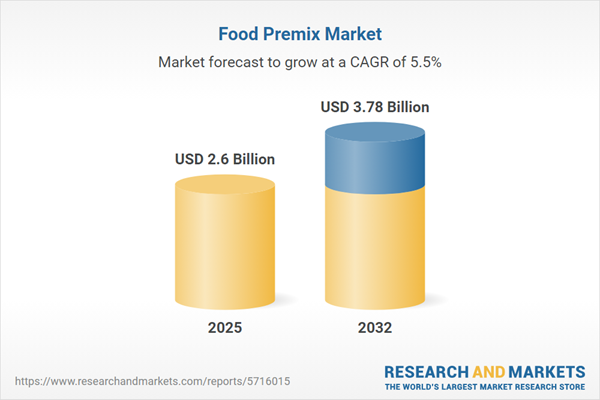Speak directly to the analyst to clarify any post sales queries you may have.
Senior decision-makers in the food premix market operate at the intersection of rising health standards, evolving regulations, and dynamic consumer demands. This market research page distills complex trends into actionable insights to support strategic planning, mitigate risk, and enhance growth opportunities.
Food Premix Market Snapshot
The food premix market is undergoing significant expansion, with a positive growth outlook through 2032. This progress is largely driven by ongoing investment in clean-label ingredients and the adoption of advanced manufacturing processes, including novel nutrient fortification methods. The sector is evolving in response to the need for agile supply networks and multifunctional product solutions adaptable across global food categories. Leading organizations are making regulatory alignment a top priority, launching localized and flexible offerings that address shifting consumer preferences. By doing so, these companies are building long-term competitiveness, supply chain security, and resilience in a rapidly changing marketplace.
Scope & Segmentation of the Food Premix Market
This report is designed for senior executives seeking to identify emerging risks, optimize entry approaches, and unlock sustained revenue opportunities in the food premix sector. In-depth segmentation informs targeted decision-making and execution across several key domains:
- End User Applications: Assess shifts in demand and specialized needs for application categories such as bakery, beverage, dairy, meat, soups, and seasonings to strategically align product distribution with evolving market trends.
- Ingredients: Review the significance and comparative advantages of principal ingredient groups, including lipase enzymes, protease enzymes, minerals, and vitamin complexes, to shape unique nutritional profiles and foster product differentiation.
- Premix Forms: Understand the operational impact and logistics of liquid versus powder premixes, taking into account production efficiency, shelf-life, and compatibility with various manufacturing settings.
- Regional Breakdown: Analyze geographic-specific consumer behaviors, regulations, and logistics environments across the Americas, Europe, Middle East, Africa, and Asia-Pacific to support market entry and ongoing expansion initiatives.
- Leading Companies: Benchmark strategic initiatives, investment themes, and adaptive frameworks from major players such as Koninklijke DSM N.V., BASF SE, Archer Daniels Midland, Cargill, International Flavors & Fragrances, Kerry Group, SternVitamin, Balchem Corporation, Kemin Industries, and Chr. Hansen Holding.
- Technologies & Trends: Evaluate the deployment and impact of microencapsulation, modular formulation, and precision fermentation technologies, alongside the influence of clean-label mandates and traceability systems in meeting regulatory and market needs.
Key Takeaways for Senior Decision-Makers
- Adopting advanced premix technologies enables alignment with evolving nutritional requirements and strengthens market positioning amid shifting consumer and regulatory expectations.
- Developing rigorous compliance and traceability systems promotes operational transparency and helps navigate regulatory changes more effectively.
- Strengthening supplier relationships and engaging in technical partnerships drive innovation cycles and accelerate regional market penetration.
- Implementing agile and adaptable manufacturing processes allows rapid responses to changes in regulations and emerging market opportunities.
- Integrating sustainable sourcing practices enhances value-chain collaboration and supports broader organizational sustainability objectives.
- Diversifying procurement strategies improves organizational flexibility and minimizes risks posed by global sourcing challenges.
Tariff Impact and Supply Chain Response
Shifts in U.S. tariff policies have adjusted cost structures and prompted new sourcing strategies within the food premix market. In response, companies focus on boosting domestic capabilities, refining logistics, and enhancing compliance systems. These measures are intended to strengthen supply continuity and ensure reliable customer support despite changing geopolitical and economic conditions.
Methodology & Data Sources
Market insights are formed through executive interviews, industry-specific surveys, regulatory audit assessments, and patent analysis. This rigorous process incorporates frameworks including Porter’s Five Forces, SWOT, PESTEL, and scenario modeling, ensuring that findings are relevant for executive decision-making priorities within the food premix market.
Why This Food Premix Market Report Matters
- Enables executive teams to make timely, evidence-based choices with clear segmentation and forecasting that enhance risk management in a volatile environment.
- Supports precise competitor benchmarking and facilitates strategic resource deployment, improving confidence in investment and growth planning decisions.
- Delivers guidance for flexible responses to evolving operational, regulatory, and supply chain challenges on both global and regional levels.
Conclusion
This report empowers senior leaders with critical insights to drive operational agility, cultivate product innovation, and strengthen integrated supply chains, supporting sustainable success in the dynamic food premix market.
Additional Product Information:
- Purchase of this report includes 1 year online access with quarterly updates.
- This report can be updated on request. Please contact our Customer Experience team using the Ask a Question widget on our website.
Table of Contents
3. Executive Summary
4. Market Overview
7. Cumulative Impact of Artificial Intelligence 2025
Companies Mentioned
The companies profiled in this Food Premix market report include:- Koninklijke DSM N.V.
- BASF SE
- Archer Daniels Midland Company
- Cargill, Incorporated
- International Flavors & Fragrances Inc.
- Kerry Group plc
- SternVitamin GmbH
- Balchem Corporation
- Kemin Industries, Inc.
- Chr. Hansen Holding A/S
Table Information
| Report Attribute | Details |
|---|---|
| No. of Pages | 185 |
| Published | October 2025 |
| Forecast Period | 2025 - 2032 |
| Estimated Market Value ( USD | $ 2.6 Billion |
| Forecasted Market Value ( USD | $ 3.78 Billion |
| Compound Annual Growth Rate | 5.4% |
| Regions Covered | Global |
| No. of Companies Mentioned | 11 |









